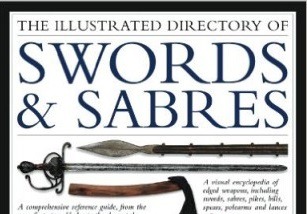An assortment of swords and rapiers in the far corner of the dining room… make a brave pretense at being legitimate collections….
-- Byron, Joseph. Photographs of New York Interiors at the Turn of the Century.
The Illustrated Directory of Swords & Sabres by Harvey J.S. Withers is anything but a pretense of a collection. Within its 150 pages, this work features about 400 "edged weapons", the swords being joined by a variety of poleaxes, lances and other pointy specialist arms, all neatly sorted into their own chapters.
Directory is, first and foremost, a beautiful catalogue of historically significant "white arms" culled from all eras and regions, each unique category sorted according to their historical period, "type", geographic origin or function. Though generally laid out by timeline, the chapters do deviate from a strict decade-by-decade advancement within themselves in order to accommodate variations in regional development or specialist purpose.
Each blade featured is beautifully photographed (oh, but to have the New York Museum of Art reissue their educational charts redone with the work of Messrs. Ombler and Cummings) and supported with nomenclature, estimated date and a short explanatory paragraph. The picture and paragraphs offered won’t make you an expert on any blade type, but they will leave you with a distinct impression of the particular weapon and its historical use.
The joy of this book, apart from its obvious beauty, is that it is truly an inexpensive coffee table discussion piece for the intermediate scholar -- as well as being a useful guide to sword types which offers a useful homogenization of sword-type terminology for the beginner swordplayer. (I anticipate that old sword hands will merely go and get a real example of the blade being discussed from their own "legitimate" collections!)
For his part, Mr Withers is well qualified to author a historical catalogue such as this. He’s been involved for over two decades in the collection, identification and -- gasp! -- commercial dealing of antique blades, and has put his experience and knowledge to good effect by authoring other, more detailed books on historical sword niches (some of which by the way, bear an uncanny resemblance and content to this one).
This is a fun, attractive, useful and inexpensive book. And if after glancing through it, if you come to the conclusion that it will not make you and expert in the design and development of your chosen sword type, you still will however understand that that not all Scottish swords are Claymores, not all Japanese swords are Katanas, and that, yes, all bastard swords were!
I have two of these. The book, I mean.
